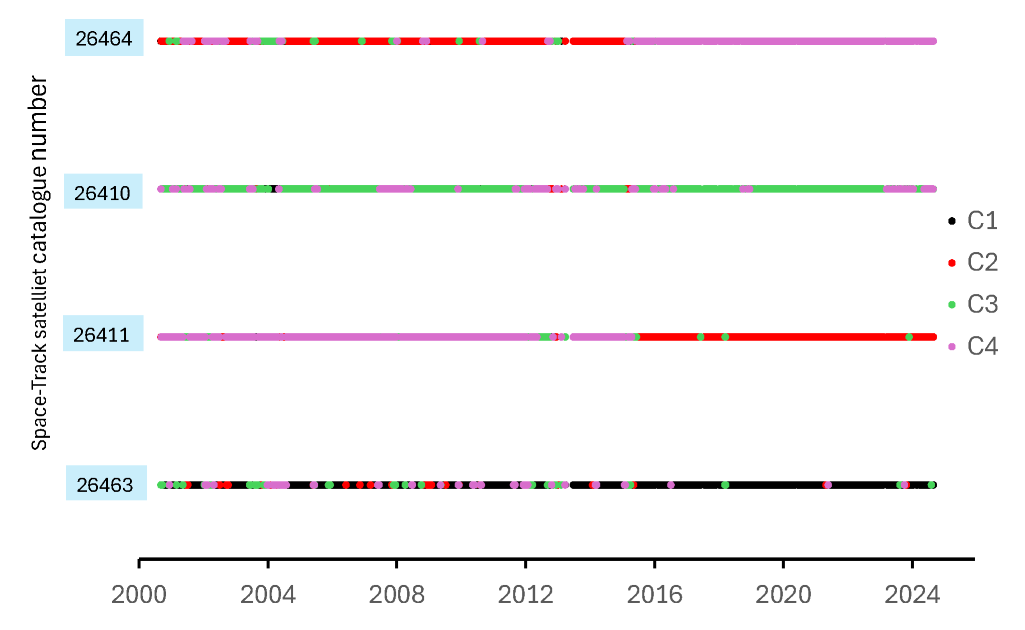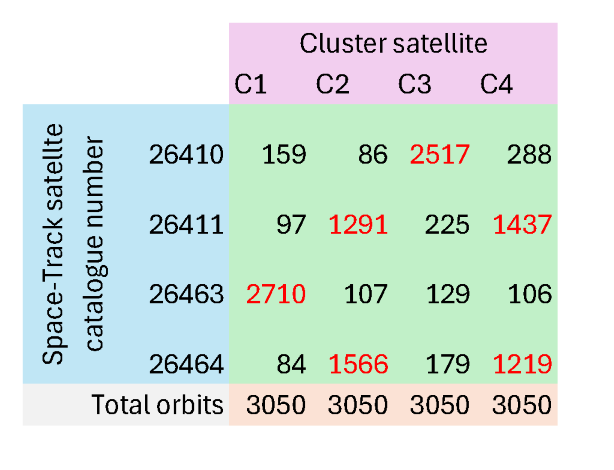Cluster Spacecraft Identifiers
This page provides a cross-reference table for the various identifiers used to describe the four Cluster spacecraft. Note that it replaces earlier analyses published in 2008 and 2017 and represents the status of those identifiers after the end of the science mission in 2024. For the completeness of the record, those older analyses are available: 2008 and 2017.
The table also includes the guidelines agreed by the Cluster Science Working
Team for plotting data from the four Cluster spacecraft.
The use of these guidelines is not mandatory. But it will make data analysis
and comparison much easier if everyone uses the same convention.
| ESA Name | | Rumba | Salsa | Samba | Tango |
| Launch date | | 9 Aug 2000 | 16 Jul 2000 | 16 Jul 2000 | 9 Aug 2000 |
| ESA Number | | 1 | 2 | 3 | 4 |
| COSPAR ID | | 2000-045A | 2000-041B | 2000-041A | 2000-045B |
| Primary Space-Track satellite catalogue number* | | 26463 | 26411 | 26410 | 26464 |
| CSDS Code | | C1 | C2 | C3 | C4 |
| ESOC FD code | | S1 | S2 | S3 | S4 |
| ESA Flight Model number | | FM5 | FM6 | FM7 | FM8 |
| | | | | | |
| Plotting guidelines |
| | | | |
| Colour | | Black | Red | Green | Magenta |
| Line Style | | Solid | Dashed | Dotted | Dash-dot-dot-dot |
| Symbols | | Cross | Plus | Asterisk | Star |
| or | | Square | Diamond | Circle | Triangle |
*IMPORTANT:
Analysis of the two-line-elements from Space-Track suggests that, in practice, the satellite catalogue numbers in those elements do not have a fixed mapping to specific Cluster spacecraft. These are mostly minor variations as you can see from the detailed analysis below. However, there is one striking feature in that, from June 2015 onwards, the primary match of C2 and C4 is swapped. Up to January 2015, Spacetrack catalogue number 26464 is mainly mapped to C2, and 26411 to C4. Then from June 2015, catalogue number 26411 is mapped to C2, and 26464 to C4. The latter is a better fit to overall mission history; C2 was one of the first pair of Clusters to be launched (along with C3) so should have a lower catalogue number than C4. Between January and June 2015, there is no clear mapping from Spacetrack catalogue numbers to ESA spacecraft numbers.
Notes
ESA Number. This is the spacecraft id used in Cluster operations by ESOC and JSOC.
COSPAR ID (also known as the International Designation). This id is assigned by the World Data Center for Satellite Information (formerly the World Data Center A for Rockets
and Satellites) at NASA Goddard Space Flight Center following spacecraft launch. It is the unique designator that is
required for all spacecraft under international law. It takes the form YYYY-LLLI, where YYYY is the year of launch,
LLL is the launch number and I is a letter that distinguish the different items launched. The COSPAR IDs assigned to the four spacecraft are reported in NASA SPACEWARN Bulletin 562, which was published in September 2000 and is available for download from the World Data Center for Satellite Information at NASA Goddard.
Space-Track catalogue number (also formerly known as the NORAD catalogue number). This is the catalogue number assigned by
the US Combined Space Operations Center (formerly Joint Space Operations Center) when an object is first tracked. The original assignment of these numbers is shown in NASA SPACEWARN Bulletin 562 and matches that shown in the table above.
CSDS code. This is the two-character spacecraft code used in the data products
produced by the Cluster Science Data System (CSDS).
ESOC FD Code. This is the two-character spacecraft code used in the names of
orbit and event files produced by ESOC Flight Dynamics.
ESA Flight Model number. These are the numbers used by ESA during the construction and ground testing of the Cluster-II spacecraft. Note that this sequence follows on from that used for the construction and ground testing of the original
Cluster-I spacecraft.
Symbols. The first set of symbols are made out of line segments, whereas
the second set may be either outlines or solid-filled.
Note that asterisks have 6 legs and stars have 5 points.
Other spacecraft linked to Cluster
Space-Track
catalogue number |
COSPAR ID |
Description |
| 26106 | 2000-015A |
This object is shown as FREGAT RB/CLUSTER 2 in the Space-Track
catalogue. It is thought to be one of the test versions of the Fregat upper stage that was flown
before the main Cluster launches. It remains in orbit in 2025 as its perigee is around 500km. |
| 26412 | 2000-041C |
This is the Fregat upper stage from the first Cluster launch. It
was intentionally de-orbited and decayed within a few hours of the launch. |
| 26465 | 2000-045C |
This is the Fregat upper stage from the second Cluster launch. It
was intentionally de-orbited and decayed within a few hours of the launch. |
Comparision of TLE data with definitive data from ESOC
To match the Space-Track catalogue numbers with the four Cluster spacecraft, we have compared perigee times from
the Space-Track two-line elements (TLE) with the definitive times in the Cluster event files provided by ESOC. We take the TLE perigee time as Tp = Te - k*MA/R, where Te is the epoch time,
MA is the mean anomaly at the epoch, R the revolution rate and k is the constant to match units of the
different elements; k= 1/360 if MA is in degrees, Tp and Te in days and R is in revolutions per day.
Note that MA must be adjusted to be in the range -180 to +180 degrees in order to derive the perigee time nearest to the epoch time.
The present analysis covers the period from 5 September 2000 to 27 August 2024 (orbits 31 to 3829), thus excluding
- the early phase of July and August 2000 when the satellites sometimes had very different orbits
- the last weeks of the science mission which saw the re-entry of the Cluster 2 spacecraft on 8 September 2024 and the divergence of the Cluster 1 spacecraft from coordinated motion with the other three spacecraft. C1's orbital period was changed from 54 to 56 hours via manouevres on 3 and 10 August 2024. These manoeuvres were undertaken as part of preparation to ensure its safe re-entry in October 2025.
We looked for orbits where Space-Track provides four distinct sets of two-line elements and hence four distinct perigee times, one for each of the Space-Track catalogue numbers. For each of these orbits we then matched the time order of the TLE-derived perigees with the time order provided by ESOC perigee times. This matching then allowed us to associate each catalogue number (24610, 24611, 24463 and 24464) with a particular Cluster spacecraft (i.e. as identified in the perigee times provided by ESOC). The table below shows an example of such matches.

Note that this match from August 2005 provides an example of how Spacetrack catalogue number 26464 was usually mapped to C2, and 26411 to C4, in the early years of the Cluster mission.
We found a total of 3050 orbits (out of 3700 orbits for which TLEs are available) in which we had four distinct TLE-derived perigee times and hence 3050 separate associations between the SpaceTrack catalogue numbers and the definitive Cluster ids provided by ESOC. The timeline of these associations is shown in the figure below. Each of the four horizontal lines indicates one of the Space-Track catalogue numbers, whilst the colours indicate which of the four Cluster spacecraft is associated with that catalogue number at any particular time. The colours follow the standard scheme as noted in the table above.

These results are summarised in the table below which shows the numbers of matches from each Space-Track catalogue numbers to each of the Cluster spacecraft. The primary matches, including the June 2015 swap of matches for 24611 and 24664, are highlighted in red, but it is clear that other matches are common.

In summary, the match of the SpaceTrack catalogue ids to ESA spacecraft numbers is correct in around 90% of cases - assuming that SpaceTrack 26464 and 26411 correctly map to Cluster C2 and C4 up to January 2015 (and, for the purposes of this analysis, up to June 2015), and that the reverse is correct from June 2015 onwards.
But that implies that the TLEs from SpaceTrack map to the wrong Cluster spacecraft in about 10% cases. This leads to the key recommendation from this analysis - namely that, wherever spacecraft positions are considered as part of the analysis of data from the four Cluster spacecraft, those positions must be calculated using the orbit and position data supplied by ESA. It is strongly recommended NOT to use TLE data from SpaceTrack for calculating Cluster spacecraft positions.
We explored whether the match of SpaceTrack catalogue ids to ESA spacecraft numbers could be improved by excluding what might be called "problem cases":
- where the Cluster orbital periods were changing quickly, say more than 60 seconds per orbit;
- where spacecraft perigees were close in time, say less than 60 seconds, such that it might be unreliable to distinguish the spacecraft by the order of their perigees.
These exclusions provided only minor improvements - with the fraction of wrong matches being reduced to 8% or 7%. This confirms the need for the recommendation above - namely to use ESOC orbit data when calculating Cluster spacecraft positions.
This analysis also allows us to compare, for each spacecraft, 3050 TLE-derived perigee times with those provided by ESOC. The time series of differences in the perigee times for each spacecraft is shown in the four figures; negative differences indicate TLE perigee times after ESOC perigee times. To be clear we compare each perigee time provided by ESA for each of C1, C2, C3 and C4 with the perigee time derived from whichever TLE best matched each ESA perigee time, following the method described earlier in this note. Thus for C2 most perigees are matched to 26464 up to January 2015 and to 26411 from June 2015 onwards - with the reverse applying for C4 perigees.
To provide good resolution in these figures, we focus on differences of plus or minus 60 minutes and ignore the small number of large outliers. This highlights a distinct oscillatory feature that starts in the summer of 2006 - this is not yet understood.
As in the previous 2017 analysis the differences in TLE versus ESOC perigee times shown in these plots are much less than those shown in the older 2008 analysis. This provides strong evidence in support of the approach above in which we match a time series of different Space-Track catalogue numbers to each Cluster. This matching provides much greater consistency between the Space-Track and ESOC datasets.
Last updated by Mike
Hapgood ( mike.hapgood@stfc.ac.uk),
12 September 2025
|